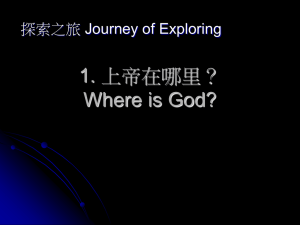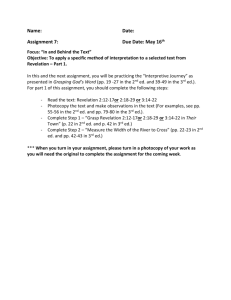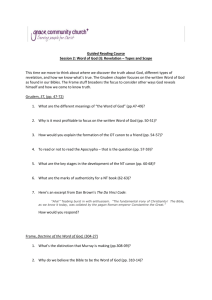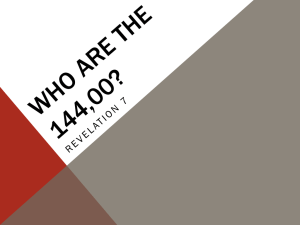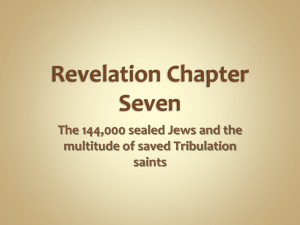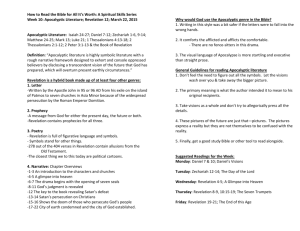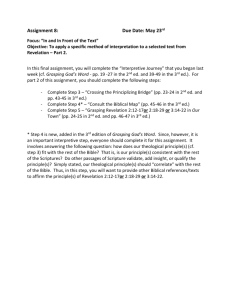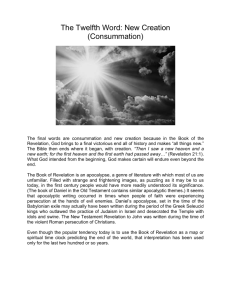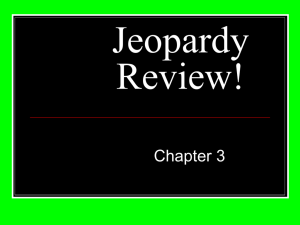Revelation
advertisement
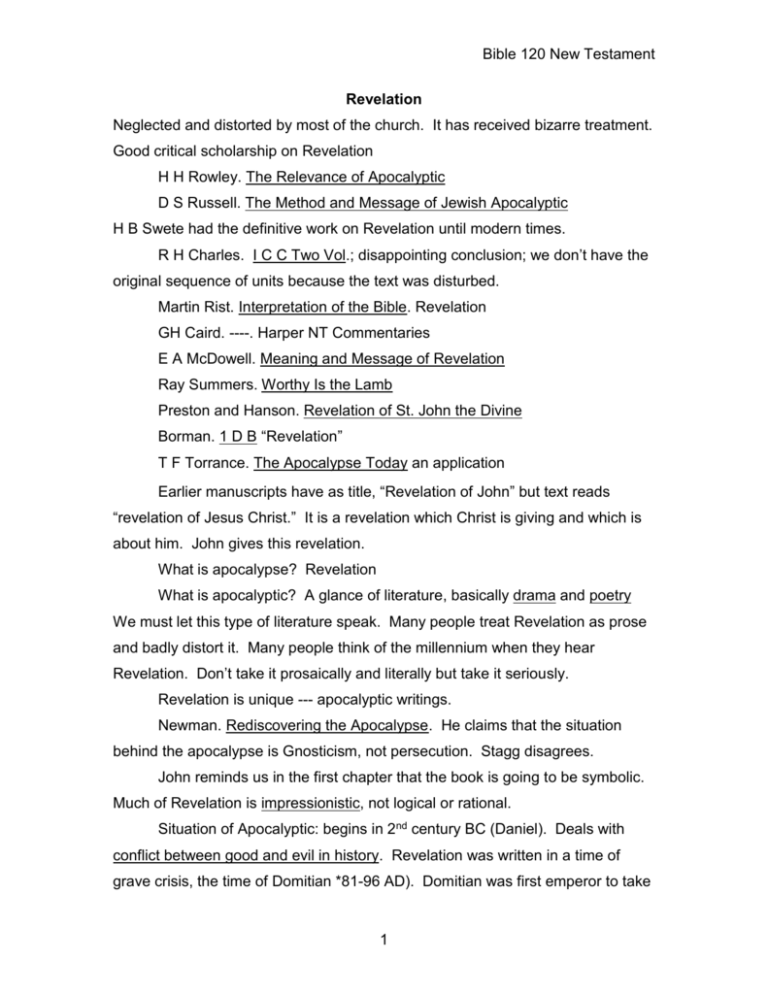
Bible 120 New Testament Revelation Neglected and distorted by most of the church. It has received bizarre treatment. Good critical scholarship on Revelation H H Rowley. The Relevance of Apocalyptic D S Russell. The Method and Message of Jewish Apocalyptic H B Swete had the definitive work on Revelation until modern times. R H Charles. I C C Two Vol.; disappointing conclusion; we don’t have the original sequence of units because the text was disturbed. Martin Rist. Interpretation of the Bible. Revelation GH Caird. ----. Harper NT Commentaries E A McDowell. Meaning and Message of Revelation Ray Summers. Worthy Is the Lamb Preston and Hanson. Revelation of St. John the Divine Borman. 1 D B “Revelation” T F Torrance. The Apocalypse Today an application Earlier manuscripts have as title, “Revelation of John” but text reads “revelation of Jesus Christ.” It is a revelation which Christ is giving and which is about him. John gives this revelation. What is apocalypse? Revelation What is apocalyptic? A glance of literature, basically drama and poetry We must let this type of literature speak. Many people treat Revelation as prose and badly distort it. Many people think of the millennium when they hear Revelation. Don’t take it prosaically and literally but take it seriously. Revelation is unique --- apocalyptic writings. Newman. Rediscovering the Apocalypse. He claims that the situation behind the apocalypse is Gnosticism, not persecution. Stagg disagrees. John reminds us in the first chapter that the book is going to be symbolic. Much of Revelation is impressionistic, not logical or rational. Situation of Apocalyptic: begins in 2nd century BC (Daniel). Deals with conflict between good and evil in history. Revelation was written in a time of grave crisis, the time of Domitian *81-96 AD). Domitian was first emperor to take 1 Bible 120 New Testament his divinity seriously and pushed for the emperor worship. The persecution provinces really pushed their divinity. Jews were exempted for this, but Christianity was not a licensed religion. To be a Christian witness () was to become a martyr. Purpose of NT Apocalypse NT Revelation not like OT Jewish apocalypse: it is not pseudonymous and does not see things in black and whit. Judgment comes first to the church in Chs. 2-3. Chapter one compares the Domitian and his legions against Christ. Wickedness seemingly triumphs, but it really is crumbled inside (Ch. 6f outer shape of victory, inner reality of defeat). Wrath of God is his turning us over to ourselves for the consequences. Evil can come on the outward guise of beauty and power (harlot city). Caesar is pictured against Christ. This is a manifest on non-violent civil disobedience. But nowhere is the sword to be reverted to. The cross (giving) is mightier than the sword. The call to worship God is strong here. Pasternak’s Dr. Zhivago might be compared to the Apocalypse in purpose. 1:3 Revelation is to be read where the Christians gathered. It is a “parlor drama,” not a staged drama, so that the reading might be able to visualize the message somewhat. Purpose 1. Worship is to be offered to God alone – not to angels or to Domitian. 2. Assurance that victory is sure for those who in their faithfulness, give their lives to Christ (writer assures that all Christians will be martyrs). The faithful have the seal of the lamb. No easy solution to the problem of good and evil (as in the Sons of Light and the Sons of darkness). Writer claims that this writing is prophecy as well as apocalyptic. Judgment begins at the house of God. The whole church is brought to judgment in Ch. 2 and 3. THEME 2 Bible 120 New Testament The ones who conquer are the ones who die and give their lives. In the face of the brutish state with its legions, court chaplains, politics and economic system, whose faith is in power (splendor), the writer bets on the triumph of that which appears to be weakness and defeat but is really glory and victory. The beast who was stricken and arose again was Nero Redivivus. That Nero was not dead. Writer uses this myth of Nero Redivivus to refer to Domitian. The counterpart of the least is the lamb who was slain and lives. The followers of the lamb, thus seemingly crushed, will finally crush the beast. Cannot conceptualize all of Revelation, for it addresses feelings as well as emotions. The “stage props,” etc, create various moods. Revelation would be best if performed or made a movie. Its success depends on how well the people “heard” and understood the message. Revelation must be read as poetry, drama, not as prose. AUTHORSHIP Traditionally applied to Apostle John. Theologically the fourth gospel and Revelation are not so far apart. Both are in simple Greek, but Revelation has more solecisms. Writer of Revelation is very descriptive and imaginative. Cannot settle the question of authorship. At beginning and end it is a letter, in the middle it is a drama. Title is added later; it gives no proof to John’s authorship. 1:1 this comes in signs and symbols 1:3 this is to be read and heard 1:4 name is John, doesn’t say which one The number seven means perfection. Numerology means the whole church. 1:5 presents Jesus Christ the faithful witness (), calling in Christians to be also faithful witnesses. Jesus is the first one from the dead, the ruler of the Kings of earth. 1:6 Christ has made us kings in his love and bond 1:9 : John is a fellow communicant : Steadfast in Jesus 3 Bible 120 New Testament Christ is alive, walking splendor among his churches. John fell at his feet, not at Domitian’s. Then the awesome Christ reached down and said, “Do not be afraid.” 2-3 Letters to the seven churches. Whatever he says to one church he says to all of the churches. He is urging against a Gnostic antinomian libertinism. He urges them to righteousness and holiness. Ephesus, left her first love as she crusaded against heresy. Smyrna: church is outwardly poor but inwardly rich. Does this bother other churches as well? Guard against inward threat. 4-5 outward thrust; scene is in heaven, all creatures are worshipping God. Ch. 4 ends with worthy art thou to receive worship and honor. Ch. 5 is worship of Christ; it closes with the worship of God and Christ together (rebuttal of Gnosticism). Ch. 4-5 form a unit. Ch. 5 – the scroll has to do with unfolding of history. There is an overcoming, but it comes in the giving of life, not in the taking of life. Christ ha already done that which assures the victory. He can break the seals on the scroll and unfold history. 5:6ff the lamb is fullness and power of vision; he has earned the right to carry himself toward its goal (5:9). Kingdom of God is not narrow nationalism; brute force is repudiated. To rule is to relinquish the right to rule and submit to God’s rule. Those who snatch at power are destroyed. The way to win is to lose. 5:10. Those who lose make up the kingdom of Christ on earth. Praise to the lamb and to God 5:12 “worthy is the lamb” 7 fold praise 5:13 “to the one sitting on the throne…” 4 fold praise Creator and redeemer are praised together. Might this be a refutation of Gnosticism? Theme of the rest of the book is that the outward form of splendor and victory is hollow inside; the outward form of defeat is one of real victory. Ch. 6 – the breaking of the seals 4 Bible 120 New Testament The four horses: White = militaristic aggression Red = bloodshed, price of war; taking life Black = inflation, hardships, famine Pale = death This is the picture of triumphant militarism shedding blood and winning victories. 6:9 the souls of those slain for their witness; the true saint gives his life. 6:10 How does one interpret this “prayer of revenge?” Is this one of the seer’s own limitations? But the saint’s prayer is denied. Saints will always be martyrs in this kind of world. The wrath of the lamb will afflict the wicked. Those who oppose him are allowed to read the fruit of their own doing. God turns man over to do his own doing. 6:16 6:12-13 Moon turns to blood and the stars fall like figs. This is a picture of wrath overtaking wickedness. All people hid from the wrath of God and the lamb (6:16). People want to die, but there is no death from this. Ch 7 – serenity of saints after the destruction of the wicked Saints are offered seals on their foreheads. They’re similar to the seal by government of good citizenship. This is the seal of the lamb – it’s guaranteed ultimate seeing but not immediate security. 7:3 - 144,000 sealed Why 12,000 from Manasseh and 12,000 from Joseph? Manasseh is subtribe of Joseph. This is not to be taken literally. 7:9 great multitude in which the martyrs who came out of tribulation (7:14) in the care of the lamb (7:17) Ch. 8 – Seventh seal opens up in terms of seven trumpets and later seven bowls of wrath. John is picturing defeat of the powers and giving comfort to the saints. Ch. 9 – 5th angel blows trumpet and a star falls from heaven into the abyss. This describes the evil ones being overtaken by evil and death. 9:6 in those days was seek death and death flees. 9:7f the destroyer and destruction of man: the locusts. 5 Bible 120 New Testament The sixth angel blows trumpet: 200 million horsemen (9:16); and yet eve with these, man doesn’t repent. Man capable of infinite good and infinite evil. Ch. 9 is a picture of the ugliness of man’s depravity. God doesn’t force anyone to be good 22:17. If man chooses to go the evil way, God will not stop him. The lake of fire is one option for man; so is the water of life. The only way to live is to serve, to die. Real fulfillment comes at the point of self-denial. Ultimate fate of thou who will not believe: inauthentic existence, not annihilation. Physical death does not terminate a man’s authority or inauthentic existence. 6
